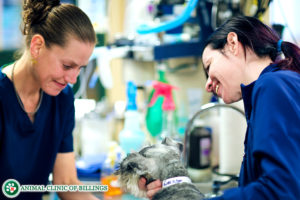Perineal Urethrostomy
What is a urethrostomy?
A urethrostomy is a surgical procedure to create a new opening in the urethra for voiding of urine. This is performed to bypass a downstream obstruction, which may be from obstructive material such as a stone or proteinaceous plug, or from scarring (stricture) or other trauma. In male cats, obstructions tend to lodge near the end of the urethra because this is the narrowest portion of the urethra. In these cases, urethrostomies are typically performed in the perineal area, beneath the anus. In dogs, obstructions are most commonly encountered in males at the base of the os penis (penis bone), where this bone restricts urethral stretching. In these cases, urethrostomies are performed in the prescrotal area, between the legs and just behind the prepuce.
What are the indications for performing a urethrostomy?
A urethrostomy is indicated when a recurrent or persistent obstruction to urine flow is present. This obstruction may consist of material such as a stone, blood clot, or plug of inflammatory debris or cellular material, or may be composed of scar tissue (called a stricture) from trauma to the urethral lining.
A perineal urethrostomy is most commonly performed in male cats suffering from a condition called Feline Idiopathic Cystitis, which causes recurrent episodes of bladder inflammation that result in the formation of plugs of inflammatory material that may lodge in the urethra, blocking urine flow. Urethral blockage is an emergency, as it will result in life-threatening electrolyte derangements and death if not relieved. For rapid relief of the blockage, an affected patient is stabilized and sedated, and a urinary catheter is used to flush the plug back into the bladder. This urinary catheter is then used to flush out the bladder and is left in place for several days while the patient receives IV fluids and medications for pain and inflammation. A special diet and environmental changes can decrease the risk of future episodes, but if the patient has a second blockage, either immediately after the first or further in the future, a perineal urethrostomy is performed to bypass the narrow portion of the urethra where plugs tend to lodge. It is very rare for a cat who has had a perineal urethrostomy to suffer from another blockage.
A prescrotal urethrostomy is most commonly performed in male dogs who have bladder stones lodged in their urethra that cannot be dislodged with a urinary catheter or that continue to form in the bladder following surgical removal and cause recurrent obstructions. Breeds predisposed to bladder stone formation include the Shih Tzu, Lhasa Apso, Miniature Poodle, Miniature Schnauzer, Pekingese, Bichon Frise, Dachshund, Cocker Spaniel, Maltese, Pomeranian, Yorkie, Chihuahua, Cairn Terrier, Dalmatian, and English Bulldog.
What is the difference between perineal and prescrotal urethrostomy?
The difference between these two surgical procedures is has to do with where the opening incision in the urethra is made. A perineal urethrostomy surgery creates an opening incision in the space between the rectum and scrotum called the perineum. The animals penis is completely excised and the urethral opening is enlarged to allow urine, stones, and other material to pass. A prescrotal urethrostomy creates an opening between the prepuce and scrotum. The animals penis is left intact, and in most cases, the dog will continue to demonstrate the same behaviors, even though the urine is voided from a different area.
What is the post-operative care for a urethrostomy?
Patients that have had a perineal or prescrotal urethrostomy must be kept calm and inactive during their recovery. It is not unusual to see a small amount of bleeding from the surgery site for several days after they go home, and this can be exacerbated by excitement or too much activity. The surgery site must be kept as clean as possible using warm wet compresses several times a day to loosen and remove any crusts and discharge.
Cats must be provided with paper litter until suture removal, and dogs should be taken outside frequently as they may temporarily experience a sensation of increased urgency. All patients that have had a urethrostomy must wear an E-collar at all times until the sutures are removed to prevent disruption of the surgical site.
What are the risks and complications?
The surgical risk for an otherwise healthy patient is low, but may be increased if the patient has a pre-existing health condition. Potential complications include post-operative bleeding, stricture formation, incontinence, and urinary tract infections. The risk of post-operative bleeding can be minimized by keeping the patient calm and sedentary for the first 10-14 days after surgery. Stricture formation, or narrowing of the urethra caused by scar tissue deposition, is uncommon with good surgical technique, but often requires a second surgery to address. The development of incontinence is also rare with good surgical technique, but due to the proximity of nerves to the surgical area, there is always a minute risk of temporary or permanent nerve injury.
All patients who have had a urethrostomy are at an increased risk of getting urinary tract infections, but male cats who have had a perineal urethrostomy have the greatest increase in risk due to the proximity of their new urethral opening to the anal area. For this reason, owners should always be on the lookout for signs of a UTI, such as straining and increased frequency of urination. Patients who have had a urethrostomy should also have a routine urinalysis performed at least every 6 months in addition to any other monitoring deemed necessary for their underlying urinary condition.

Let our highly trained and experienced team of veterinarians and veterinary technicians help you keep your cat as happy and healthy as they can be.
Call the Animal Clinic of Billings and Animal Surgery Clinic to schedule your pet cat’s next wellness examination with one of our veterinarians today!
406-252-9499 REQUEST AN APPOINTMENT



